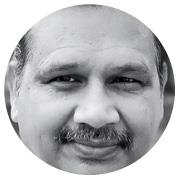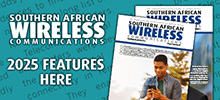05 December 2022

Dr Junaid Syed
senior vice president, engineering
and operations, Curvalux
What was your big career break?
My first career break came thanks to a so-called ‘failure.’
I was training to become a pilot as part of my first degree in aero sciences, when I had a realisation; the world of academia was my strong suit, the cockpit, well, a little less so. Flying was not the right profession for me. I recognised this ‘failure’ as constructive feedback and changed my path.
This was a significant turning point. I returned to university to continue my studies, taking an electronics engineering degree with majors in microwave and aircraft electronics, graduating with a gold medal.
I spent several years working in academia and industry as a R&D designer producing patents for wireless communications and actively contributing to regulatory bodies. This led to my second eureka career moment; I decided to add commercial experience to my R&D background. That allowed me to talk to customers and have a better grasp of the problems in the real world. Suddenly I was faced with hurdles like climbing towers, network optimisation, budgets, and an array of constraints that operators must deal with daily.
Nowadays, I can wear an R&D or a business hat depending on the situation and can act as an interpreter that brings these two worlds closer together.
Who was your hero when you were growing up?
I am fascinated by the world of technical innovation. Scientists leading R&D have always had my admiration. As a young student, I learnt about James Maxwell, responsible for the classical theory of electromagnetic radiation. At that time, I did not really appreciate his works, however, later when I was working in industry and able to see the application of his theory, all clicked into place, and he became my hero.
If you had to work in a different industry, which one would you choose?
I find artificial intelligence (AI) fascinating. AI is not a field on its own, in fact, intelligence is being applied and developed in every industry, including telecommunications, where it is enabling exciting developments. In the case of the antennas, it helps create software defined antennas that can dynamically adapt to changes in the environment.
Where would you live if money was no object?
Scotland has been my home for the last 20+ years, and I love it here. It is beautiful and peaceful, out of my window, all I can see are rolling fields and sheep. In the past, I thoroughly enjoyed living and working in many countries in Asia, the Middle East, America and Europe. It is enriching to meet people from different cultures, and I feel fortunate to now work alongside an international team spread across the world.
Which law would you most like to change?
Almost half of the world’s population has no or poor connectivity. The pandemic has demonstrated ever-growing demand, that having internet access is no longer a luxury, but has become a necessary requirement for economic growth, education and entertainment.
To be able to serve the community without hindering other services, we need to look at the regulations to facilitate the use of new technologies providing connectivity to the unconnected. I’d like regulatory bodies to change the regulation for spectrum allocation and management to help companies expedite the development of innovative technology, to make more efficient use of the spectrum and be brought to market as soon as possible.
“Ideas alone are not enough to drive innovation; turning concepts into solutions, financing the development, satisfying demand are some of the many factors required
for ideas to take shape and materialise. ”
What’s the strangest question you’ve ever been asked?
When I was a member of the ETSI TM4 committee, I highlighted the need for more innovative work in antenna development, including updating regulations from an antenna design perspective. As I was representing an antenna manufacturer, I was asked; “Why don’t we see much change in the design of antennas?” I took that back to the manufacturer with the understanding that the ETSI would work to support antenna innovation through developing new standards. The response from my employer was extremely positive and triggered the beginning of a series of novel design works to design antennas more efficiently.
What would you do to increase the speed of innovation?
Ideas alone are not enough to drive innovation; turning concepts into solutions, financing the development, satisfying demand are some of the many factors required for ideas to take shape and materialise.
We can accelerate innovation through a structured approach by using the TRIZ Matrix to formalise the process of innovations. It works by analysing how generic problems are resolved and then you can customise that method to your specific problem increasing the speed of the resolution.
I am also a firm believer that close collaboration between academia, industry and government is key to drive development of ideas and innovation.
What’s the greatest technological advancement in your lifetime?
I may be biased but I think the biggest breakthrough in my lifetime is in telecommunications.
The advancement in mobile & satellite communication technologies, devices, optical fibre, IoT is unprecedented and have reduced the world to a global village. The development of both terrestrial and satellite communications has changed our lifestyle, the way we do operate. It has opened a world of possibilities and empower people whose visibility may have been hidden or voice unheard.
What’s the one possession you can’t live without?
I have always believed that there is not one single physical thing I cannot live without at this stage in my life. I would miss open spaces of natural beauty though if I did not have access to them.
What would you do with US$1 million?
I’d happily get involved in scientific research to design and produce innovative solutions to solve the world’s problems like connectivity for all.
I’d love to become hands-on in research facilities but also channel some of those funds towards charity organisations working to support clean drinking water and the education of gifted underprivileged students.






